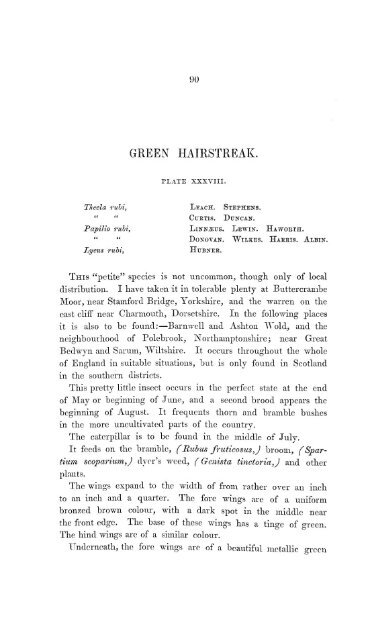- Page 2:
$3% Jahn* ^&t*
- Page 9:
TO THE HON. MRS. M1TSGRAVE, BISHOPT
- Page 12 and 13:
Painted Lady Scarce Painted Lady Pu
- Page 14 and 15:
via INTRODUCTION. more captivatingl
- Page 16 and 17:
2 SWALLOW-TAIL the Himalayan mounta
- Page 18:
PLATE II. 4 SCARCE SWALLOWTAIL. Pap
- Page 24 and 25:
6 SCARCE SWALLOW-TAIL. specimen whi
- Page 26:
8 BRIMSTONE. PLATE III. Oonepteryx
- Page 32:
10 CLOUDED YELLOW PL A TiC IV Colla
- Page 38 and 39:
12 CLOUDED YELLOW. localities for t
- Page 40:
14 PALE CLOUDED YELLOW PLATE V. Col
- Page 46:
16 BLACK YEINED. PLATE VI. Pieris c
- Page 52:
is LARGE WHITE. PLATE VII. Pontia b
- Page 57 and 58:
LARGE WHITE. a singularly small spe
- Page 63 and 64:
21 SMALL WHITE. PLATE VIII. Pontia
- Page 66:
22 SMALL WHITE. The caterpillar fee
- Page 72 and 73:
24 GREEN VEINED. edge of the wing:
- Page 74:
PLATE X. 26 CHEQUERED WHITE. BATH W
- Page 82:
28 CHEQUERED WHITE. hind wings are
- Page 88:
30 WOOD WHITE. and Sarum, Wiltshire
- Page 94:
32 ORANGE TIPPED. and the open path
- Page 100 and 101:
34 MARBLED WHITE. There is hardly a
- Page 102:
36 WOOD ARGUS. WOOD LADY. SPECKLED
- Page 108:
38 WOOD RINGLET. PLATE XV Hipparchi
- Page 114:
« ((
- Page 120:
42 ROCK-EYED UNDERWING. GRAYLING. P
- Page 126:
44 SMALL MEADOW BROWN. LARGE HEATH,
- Page 132:
46 LARGE MEADOW BROWN. MEADOW BROWN
- Page 138:
Biipparchia davus, " polydama, (var
- Page 146:
50 HEATH BUTTERFLY. permanent varie
- Page 152:
52 LEAST MEADOW BROWN. Underneath,
- Page 158:
54 ARRAN ARGUS. ular white band, be
- Page 165:
56 SCOTCH ARGUS. uniform dark bronz
- Page 171:
58 SMALL RINGLET. The hind wings ha
- Page 177:
60 SILVER-BORDERED RINGLET. orange,
- Page 183 and 184:
62 WHITE ADMIRAL. large white spots
- Page 185:
ALDERMAN BUTTERFLY. PLATE XXV11. 64
- Page 191:
vs RED ADMIRAL. over, in a manner t
- Page 197:
68 PEACOCK. the other, which latter
- Page 203 and 204: 70 LARGE TORTOISE-SHELL. survive th
- Page 205: PLATE XXX. 72 SMALL TORTOISE-SHELL.
- Page 211: (4 CAMBERWELL BEAUTY WHITE BORDER.
- Page 217: 76 CAMBERWELL BEAUTY. The caterpill
- Page 223 and 224: 78 COMMA. the sunshine, too soon to
- Page 225: PLATE XXXIII. 80 ALBIN'S HAMPSTEAD
- Page 235: 82 PAINTED LADY. of Switzerland in
- Page 242 and 243: HUNTER'S CYNTHIA. PLATE XXXA" S3 SC
- Page 248 and 249: EMPEROR OF MOROCCO. PLATE XXXVI. 85
- Page 250 and 251: PURPLE EMPEROR. that the neighbouri
- Page 262 and 263: GREEN HAIRSTREAK. 91 colour, except
- Page 268 and 269: dot outside the tail, from which R
- Page 273: PLATE XLI. » 96 BROWN HAIRSTREAK.
- Page 279: PLATE XLII. 98 DUKE OF BURGUNDY FRI
- Page 285: 100 DUKE OF BURGUNDY FRITILLARY. of
- Page 291 and 292: 102 GREASY FRITILLARY. It feeds on
- Page 293: Melitoea cinxia, it Papilio a a a a
- Page 299: PLATE XLA\ 106 PEARL-BORDERED FRITI
- Page 305:
108 SMALL PEARL-BORDERED FRITILLARY
- Page 311:
110 SMALL PEARL-BORDERED FRITILLARY
- Page 317 and 318:
112 PEARL-BORDERED LIKENESS FRITILL
- Page 319:
PLATE XLVI1I. 114 WEAVER'S FRITILLA
- Page 325:
PLATE XLIX. 116 HIGH BROWN FRITILLA
- Page 331:
118 HIGH BROWN FRITILLARY. black ma
- Page 337 and 338:
120 DARK GREEN FRITILLARY. dark mar
- Page 339:
1 (,>.,> QUEEN OF SPAIN FRITILLARY.
- Page 345:
PLATE LII. 124 VENUS FRITILLARY Arg
- Page 355:
126 SILVER-WASHED FRITILLARY. towar
- Page 361 and 362:
128 LARGE COPPER. the mercantile, t
- Page 363:
130 SMALL COPPER. COMMON COPPER. CO
- Page 369:
132 MAZARINE BLUE. PLATE LVI. Polyo
- Page 375:
132 MAZARINE BLUE. PLATE LAI. Polyo
- Page 381:
PLATE LVII. 134 LARGE BLUE. Polyomm
- Page 388:
AZURE BLUE. PLATE LVIII. 136 HOLLY
- Page 392:
BEDFORD BLUE. PLATE LIX. 13
- Page 398:
Polyommatus argus, a a " alcippe, 1
- Page 404:
142 SILVER-STUDDED BLUE. eyed spot,
- Page 410 and 411:
144 COMMON BLUE. deprives it of muc
- Page 412:
146 CLIFDEN BLUE. HARTFORD BLUE. PL
- Page 418:
LXIII. 148 CHALK HILL BLUE. Polyomm
- Page 424:
150 CHALK HILL BLUE. Underneath, th
- Page 429 and 430:
152 BROWN ARGUS BLUE. Castle; Jardi
- Page 431:
Besperia malva, ci a Papilio « a
- Page 437:
PLATE LXVI. 156 DINGY SKIPPER. Hesp
- Page 443:
PLATE LXVII. 15S LARGE SKIPPER. Hes
- Page 449:
Hesperia comma, a it 160 SILVER-SPO
- Page 455:
162 SMALL SKIPPER. PLATE LXIX. Hesp
- Page 461:
164 LULWORTH SKIPPER. PLATE LXX. He
- Page 467:
Plesperia paniscus, a it Papilio pa
- Page 473:
168 SPOTTED SKIPPER. is but the cen
- Page 478:
Fly extended.
- Page 481 and 482:
2 APHORISM ATA ENTOMOLOGICA. When,
- Page 483 and 484:
4 APHOEISMATA ENTOMOLOGICA. desirou
- Page 485 and 486:
6 APHORISM ATA ENTOMOLOGICA. If you
- Page 487 and 488:
3 APH0RI8MATA ENT0M0L0GICA. The fol
- Page 489 and 490:
10 APHORISMATA ENT0M0L0GICA. worthi
- Page 491 and 492:
12 APHORISMATA ENTOMOLOGICA- possib
- Page 493 and 494:
1G APHOEISMATA ENTOMOLOGICA. catalo
- Page 495 and 496:
IS APHORISMATA ENTOMOLOGICA. the in
- Page 497 and 498:
'JO APII.0KISMATA ENTOMOLOGICA. tha
- Page 499 and 500:
22 APHOEISMATA ENTOMOLOGICA. Barber
- Page 501 and 502:
21, APHORISMATA ENTOMOLOGTCA. the s
- Page 503 and 504:
20 APHORISMATA ENTOMOLOGICA. and br
- Page 505 and 506:
28 APHORISMATA 1NTOMOLOGICA. they a
- Page 512:
ORIENTAÇÕES PARA O USO Esta é um

















